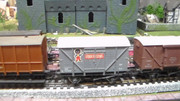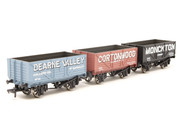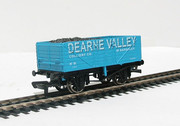Re: Private owner wagons
Posted: Thu Aug 06, 2020 7:11 pm
There were approximately 600,000 privately owned wagons in service on the UK railways in 1938 owned by approximately 4,000 different traders some large with fleets of 2,000 or more, other small with one or two vehicles.
Wagons had to display the owners name and address, tare weight and carrying capacity in paint on the side and the registration number on a cast metal plate attached to the solebar.
Apart from tank wagons for which there were strict rules about the colour the wagon could be painted traders were free to paint their wagon any colour they wished.
They could write any other lettering on the wagon and most choose to display their trading name in large letters and some words describing their business. This did not need to say what was in the wagon (apart from some tank wagons or wagons carrying explosives or other dangerous goods) and well over 80% were carrying coal or coke in any case. This fuel was usually for sale, or in case of wagons owned by manufacturers to stoke their boilers in their factory.
Large well known manufacturers might use their wagons as mobile advertising hoardings, so for example soap manufacturers may write the name of their best brand on the wagon in large letters.
All this came to a halt in 1939 when all the privately owned (apart from tank wagons and a few wagons for special traffic) were requisitioned by the Government and pooled so they could be used where necessary by the Ministry of War transport. Oil tank wagons were pooled by the Petroleum Board but remained in private hands.
In 1948 all the requisitioned wagons were sold to British Railways, but a few were handed to the National Coal Board to use internally at collieries.
British Railways did not immediately repaint these wagons but changed the number to a new one recognised by a 'P' prefix. The new number was painted on a black panel in white paint at the extreme left hand bottom corner. The original paint was allowed to fade and any replacement of damaged woodwork was left unpainted. is meant the old trader livery was still visible although getting more and more scruffy as time went on.
Most of these old Private Owner wagons were pretty old and tatty by 1948 and most were broken up by the end of the 1960s.
Model manufacturers like these wagons because they are small but colourful and quite popular because of that. Some are sold in authentic liveries but a lot are in imaginary or fake schemes, Older models are particularly bad for this fakery, and a lot were in garish colours. This started with Hornby tinplate in the 1920s and can still be found today, usually on the cheaper models.
If you want authenticity you need to do a moderate amount of research. There are plenty of books about private owner wagons, and Hornby and Bachmann do sell vehicles in correct colours . Beware old Lima, and wagons by companies in the 1970s and 1980s.
Since the 1960s modern high capacity air braked private owner wagons had a revival, especially aggregate hoppers, and containers.
Wagons had to display the owners name and address, tare weight and carrying capacity in paint on the side and the registration number on a cast metal plate attached to the solebar.
Apart from tank wagons for which there were strict rules about the colour the wagon could be painted traders were free to paint their wagon any colour they wished.
They could write any other lettering on the wagon and most choose to display their trading name in large letters and some words describing their business. This did not need to say what was in the wagon (apart from some tank wagons or wagons carrying explosives or other dangerous goods) and well over 80% were carrying coal or coke in any case. This fuel was usually for sale, or in case of wagons owned by manufacturers to stoke their boilers in their factory.
Large well known manufacturers might use their wagons as mobile advertising hoardings, so for example soap manufacturers may write the name of their best brand on the wagon in large letters.
All this came to a halt in 1939 when all the privately owned (apart from tank wagons and a few wagons for special traffic) were requisitioned by the Government and pooled so they could be used where necessary by the Ministry of War transport. Oil tank wagons were pooled by the Petroleum Board but remained in private hands.
In 1948 all the requisitioned wagons were sold to British Railways, but a few were handed to the National Coal Board to use internally at collieries.
British Railways did not immediately repaint these wagons but changed the number to a new one recognised by a 'P' prefix. The new number was painted on a black panel in white paint at the extreme left hand bottom corner. The original paint was allowed to fade and any replacement of damaged woodwork was left unpainted. is meant the old trader livery was still visible although getting more and more scruffy as time went on.
Most of these old Private Owner wagons were pretty old and tatty by 1948 and most were broken up by the end of the 1960s.
Model manufacturers like these wagons because they are small but colourful and quite popular because of that. Some are sold in authentic liveries but a lot are in imaginary or fake schemes, Older models are particularly bad for this fakery, and a lot were in garish colours. This started with Hornby tinplate in the 1920s and can still be found today, usually on the cheaper models.
If you want authenticity you need to do a moderate amount of research. There are plenty of books about private owner wagons, and Hornby and Bachmann do sell vehicles in correct colours . Beware old Lima, and wagons by companies in the 1970s and 1980s.
Since the 1960s modern high capacity air braked private owner wagons had a revival, especially aggregate hoppers, and containers.


